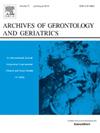昼夜节律基因隐色素2 (Cry2)与脂质代谢相互作用促进血管衰老。
IF 3.5
3区 医学
Q2 GERIATRICS & GERONTOLOGY
引用次数: 0
摘要
背景:血管老化是许多老年人慢性疾病的基础,如高血压、冠心病、中风等。目的:本研究旨在结合多种大数据研究方法,加深对血管衰老病理机制的认识,揭示潜在的治疗靶点和生物标志物。方法:采用WGCNA方法整合多个年龄阶段的主动脉转录组数据,提取关键模块和关键通路。采用JTK算法对主动脉节律基因进行整合。对核心基因和相关通路进行相关性计算。最后,在细胞衰老过程中验证了核心基因的表达及其与相关通路的相互作用。结果:WGCNA显示昼夜节律是血管衰老的关键通路,昼夜节律与代谢相互作用促进血管衰老的发生。Cry2已被确定为最关键的核心节律基因。脂质代谢是与Cry2相关程度最高的亚通路,其中磷脂代谢和Serac1与Cry2的相关性最强且最显著。Cry2主要分布在年轻和衰老血管内皮细胞中,影响内皮衰老过程中脂质转运等5个脂质相关代谢过程。结论:本研究提示昼夜节律和Cry2可能是血管衰老的潜在靶点,进一步研究其与脂质代谢的相互作用将为年龄相关性血管疾病的预防和治疗提供有效的策略。本文章由计算机程序翻译,如有差异,请以英文原文为准。

Circadian rhythm gene cryptochrome 2 (Cry2) interacts with lipid metabolism to promote vascular aging
Background
Vascular aging is the basis of many chronic diseases of the aged, such as hypertension, coronary heart disease and stroke.
Objective
This study aims to deepen our understanding of the pathological mechanisms of vascular aging by combining multiple big data research methods, and reveal potential therapeutic targets and biomarkers.
Methods
WGCNA method was used to integrate the aortic transcriptome data of multiple age stages, and extract the key module and key pathway. The gene of aortic rhythm was integrated by JTK algorithm. Correlation calculation was performed for core gene and associated pathways. Finally, the expression of the core gene and their interaction with the associated pathways were verified in cell senescence.
Results
WGCNA showed that circadian rhythm is the key pathway of vascular aging, and circadian rhythm and metabolism interact to promote the occurrence of vascular aging. Cry2 has been identified as the most critical core rhythm gene. Lipid metabolism is the most Cry2-related subpathway, among which phospholipid metabolism and Serac1 have the strongest and most significant correlation with Cry2. Cry2 is mainly distributed in endothelial cells in both young and senescent blood vessels, and affects five lipid-related metabolic processes including lipid transport during endothelial senescence.
Conclusion
This study suggests that circadian rhythm and Cry2 may be potential targets of vascular aging, and further studies on their interaction with lipid metabolism will provide effective strategies for the prevention and treatment of age-related vascular diseases.
求助全文
通过发布文献求助,成功后即可免费获取论文全文。
去求助
来源期刊
CiteScore
7.30
自引率
5.00%
发文量
198
审稿时长
16 days
期刊介绍:
Archives of Gerontology and Geriatrics provides a medium for the publication of papers from the fields of experimental gerontology and clinical and social geriatrics. The principal aim of the journal is to facilitate the exchange of information between specialists in these three fields of gerontological research. Experimental papers dealing with the basic mechanisms of aging at molecular, cellular, tissue or organ levels will be published.
Clinical papers will be accepted if they provide sufficiently new information or are of fundamental importance for the knowledge of human aging. Purely descriptive clinical papers will be accepted only if the results permit further interpretation. Papers dealing with anti-aging pharmacological preparations in humans are welcome. Papers on the social aspects of geriatrics will be accepted if they are of general interest regarding the epidemiology of aging and the efficiency and working methods of the social organizations for the health care of the elderly.

 求助内容:
求助内容: 应助结果提醒方式:
应助结果提醒方式:


